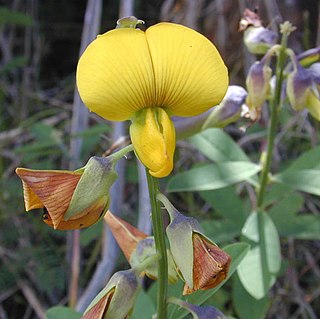
The Faboideae are a subfamily of the flowering plant family Fabaceae or Leguminosae. An acceptable alternative name for the subfamily is Papilionoideae, or Papilionaceae when this group of plants is treated as a family.

Phaseolus is a genus of herbaceous to woody annual and perennial vines in the family Fabaceae containing about 70 plant species, all native to the Americas, primarily Mesoamerica.

The mung bean, alternatively known as the green gram, maash ٫ mūng, monggo, đậu xanh, pesalu, kacang hijau or munggo (Philippines), is a plant species in the legume family. The mung bean is mainly cultivated in East, Southeast and South Asia. It is used as an ingredient in both savoury and sweet dishes.

The cowpea is an annual herbaceous legume from the genus Vigna. Its tolerance for sandy soil and low rainfall have made it an important crop in the semiarid regions across Africa and Asia. It requires very few inputs, as the plant's root nodules are able to fix atmospheric nitrogen, making it a valuable crop for resource-poor farmers and well-suited to intercropping with other crops. The whole plant is used as forage for animals, with its use as cattle feed likely responsible for its name.

Vigna is a genus of plants in the legume family, Fabaceae, with a pantropical distribution. It includes some well-known cultivated species, including many types of beans. Some are former members of the genus Phaseolus. According to Hortus Third, Vigna differs from Phaseolus in biochemistry and pollen structure, and in details of the style and stipules.

Vigna mungo, also known as black gram, urad bean, urid bean, matimah, matikolai, mash kalai, uzhunnu parippu, ulundu paruppu, minapa pappu, uddu, or black matpe, is a bean grown in South Asia. Like its relative, the mung bean, it has been reclassified from the Phaseolus to the Vigna genus. The product sold as black lentil is usually the whole urad bean, whereas the split bean is called white lentil. It should not be confused with the much smaller true black lentil.

Vigna aconitifolia is a drought-resistant legume, commonly grown in arid and semi-arid regions of India. It is commonly called mat bean, moth bean, matki or dew bean. The pods, sprouts and protein-rich seeds of this crop are commonly consumed in India. Moth bean can be grown on many soil types, and can also act as a pasture legume.

The plant tribe Phaseoleae is one of the subdivisions of the legume subfamily Faboideae, in the unranked NPAAA clade. This group includes many of the beans cultivated for human and animal food, most importantly from the genera Glycine, Phaseolus, and Vigna.
Condylostylis is a small genus of flowering plants in the legume family, Fabaceae. It belongs to subfamily Faboideae. The genus includes four species native to the tropical Americas, ranging from southeastern Mexico to northern Argentina. Species in this genus were formerly considered to belong to the genus Vigna.
Dolichopsis is a small genus of flowering plants in the legume family, Fabaceae. It belongs to the subfamily Faboideae. It includes three species native to South America, ranging from west-central and southeastern Brazil to Bolivia, Paraguay, and northern Argentina.

Leptospron is a small genus of flowering plants in the legume family, Fabaceae. It contains two species with a pantropical distribution. It belongs to the subfamily Faboideae. Species in this genus were formerly considered to belong to the genus Vigna.
Mysanthus uleanus is a species of flowering plant in the legume family, Fabaceae. It is a climbing herb endemic to eastern Brazil. It grows in seasonally-dry tropical wooded grassland, thorn scrub, rocky shrubland, and in degraded areas. It is the only described member of the genus Mysanthus, though there is a report of an undescribed species. The genus belongs to subfamily Faboideae.

Oxyrhynchus is a small genus of flowering plants in the legume family, Fabaceae. It includes four species, three native to the tropical Americas from northern Mexico to Colombia, and one native to New Guinea, Maluku, and the Bismarck Archipelago. It belongs to the subfamily Faboideae. A key for the species in this genus has been published.

Sigmoidotropis is a genus of flowering plants in the legume family, Fabaceae. It includes eight species native to the tropical Americas, ranging from northern Mexico and the Caribbean islands to southern Brazil. It belongs to the subfamily Faboideae. Species in this genus were formerly considered to belong to the genus Vigna.

Ocys is a genus of ground beetles in the family Carabidae. There are at least 30 described species in Ocys.
Doderotrechus is a genus in the beetle family Carabidae. There are at least three described species in Doderotrechus, found in Italy.
Guizhaphaenops is a genus in the beetle family Carabidae. There are about eight described species in Guizhaphaenops, found in China.
Helicotropis is a small genus of flowering plants in the legume family, Fabaceae. It belongs to the subfamily Faboideae. It includes three species of perennial climbing vines native to the tropical Americas, ranging from southern Mexico to northeastern Argentina. Species in this genus were formerly considered to belong to the genus Vigna.

Ramirezella is a small genus of flowering plants in the family Fabaceae. It includes seven species of climbing herbs native to southern North America, ranging from northern Mexico and Nicaragua. Typical habitats include seasonally-dry tropical forest and secondary vegetation in disturbed areas. It belongs to the subfamily Faboideae.

Wajira is a small genus of flowering plants in the legume family, Fabaceae. It includes five species of climbing herbs or subshrubs native to tropical Africa, the Indian subcontinent, and Thailand. Four species are native to the Somali-Masai region of northeastern tropical Africa. Wajira grahamiana is more widespread in Africa and ranges to the Indian subcontinent and Indochina. Typical habitats are seasonally-dry tropical forest, woodland, bushland, and grassland. It belongs to the subfamily Faboideae. Species in this genus were formerly considered to belong to the genus Vigna. A key for the genus has been published.














